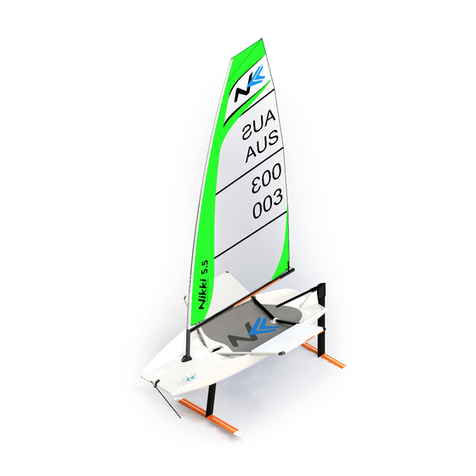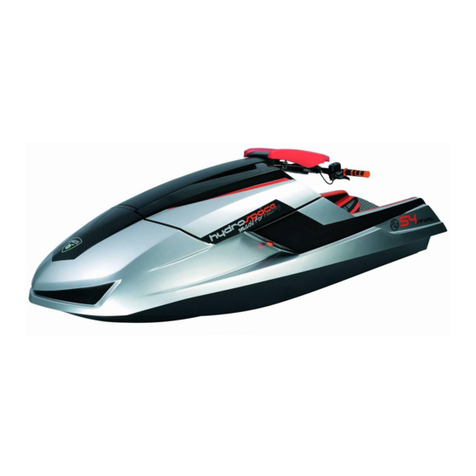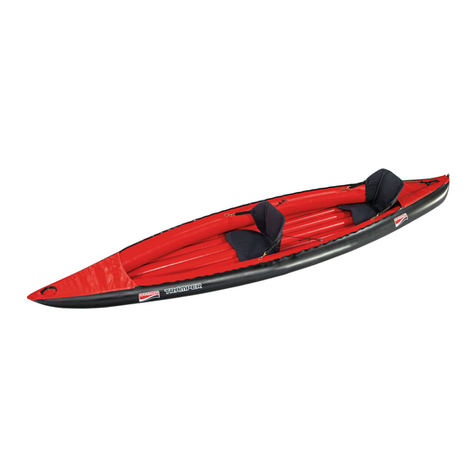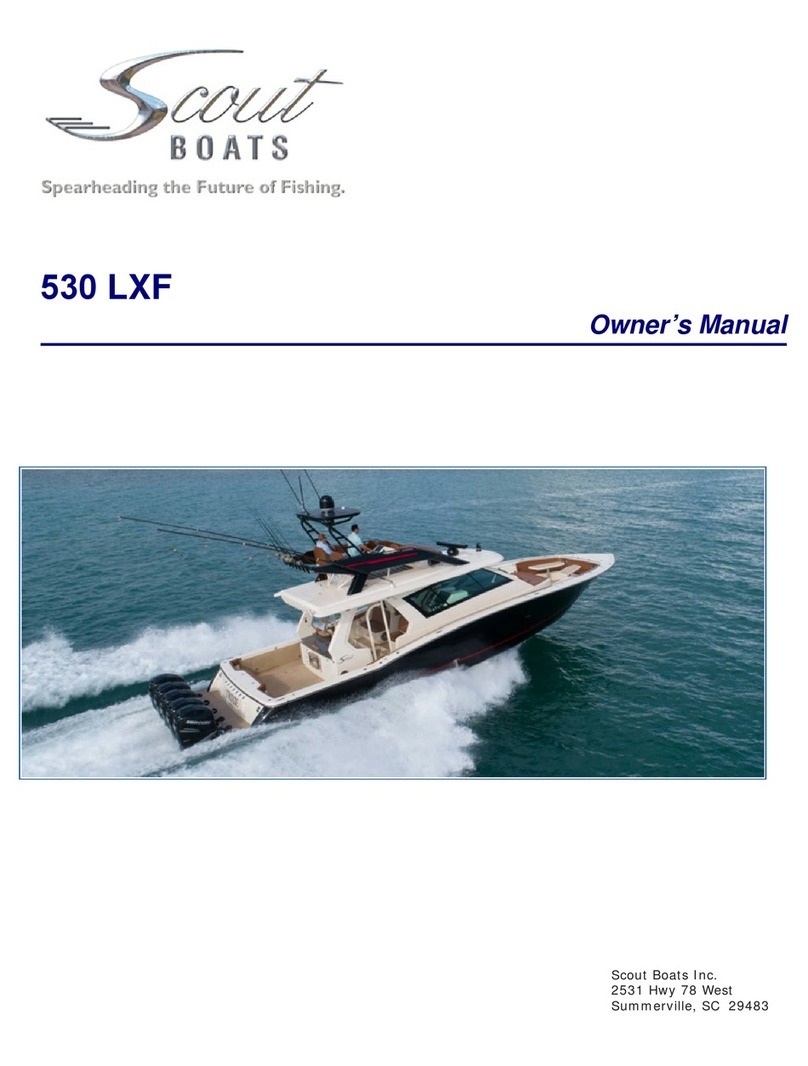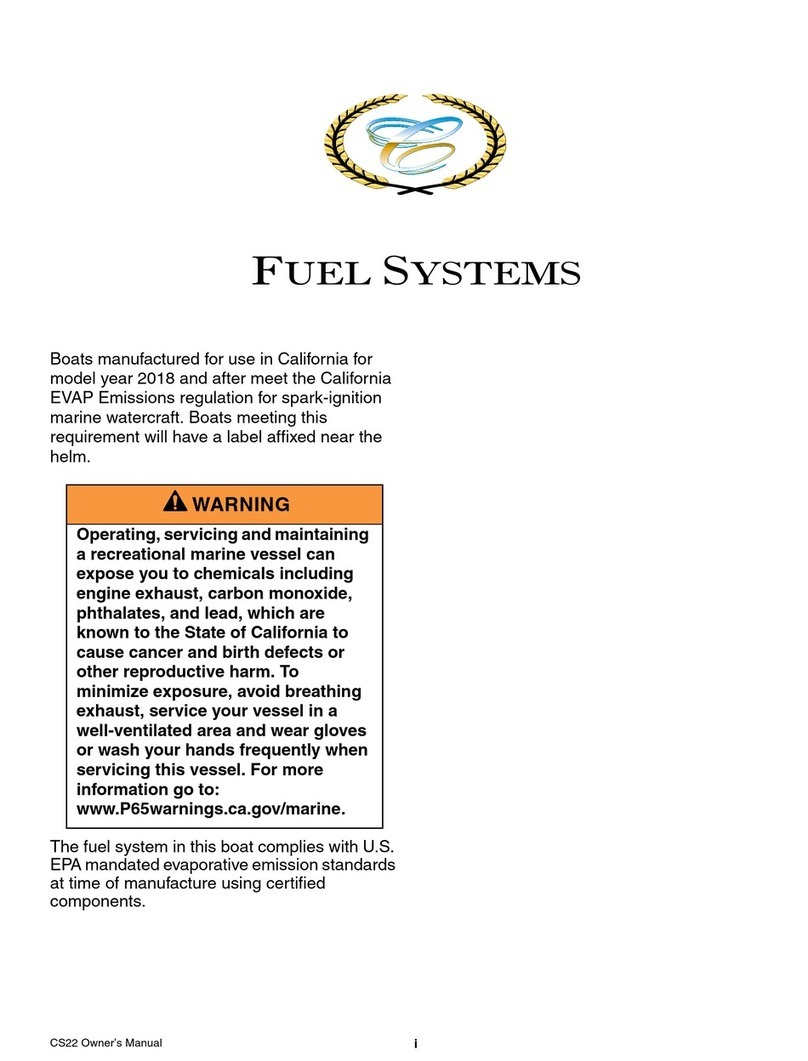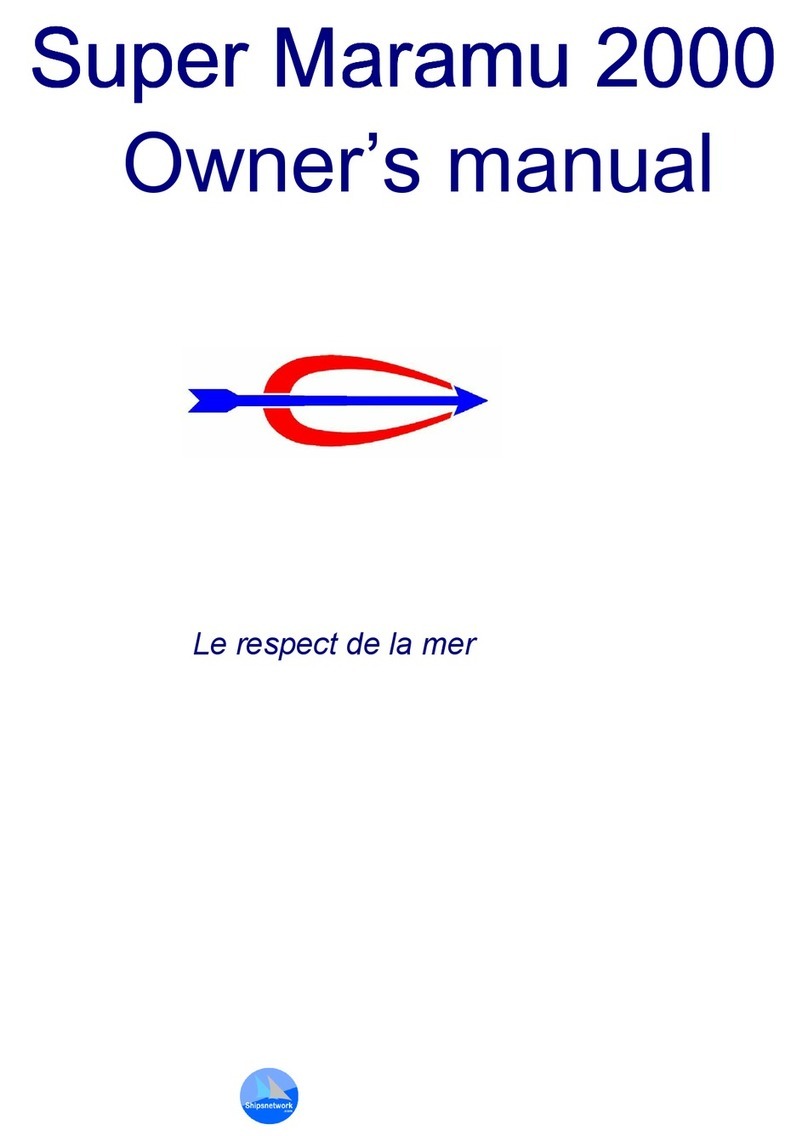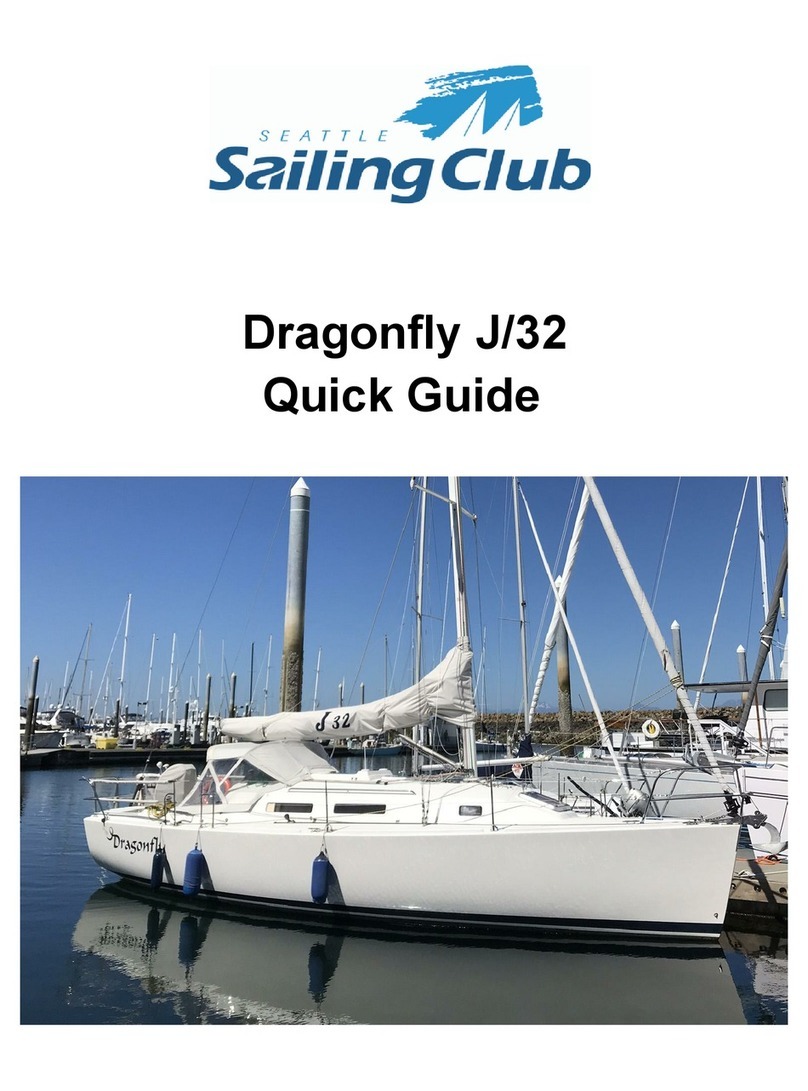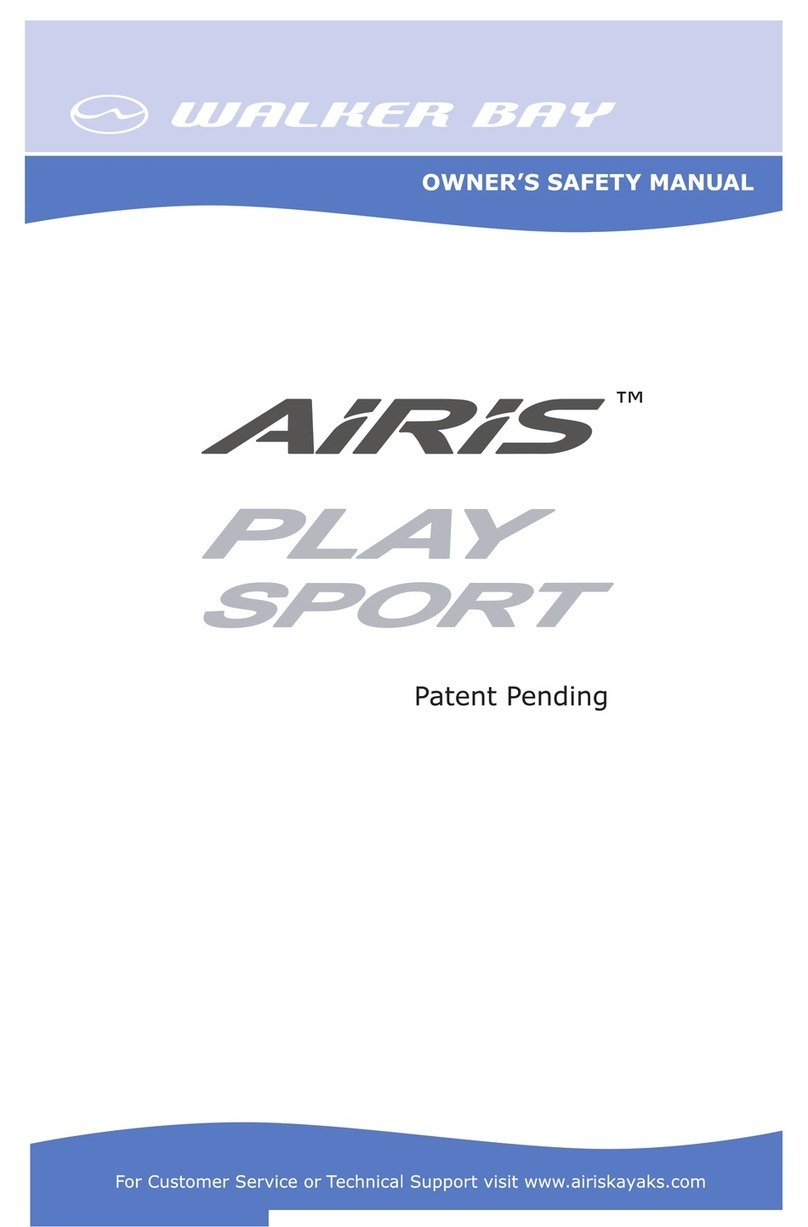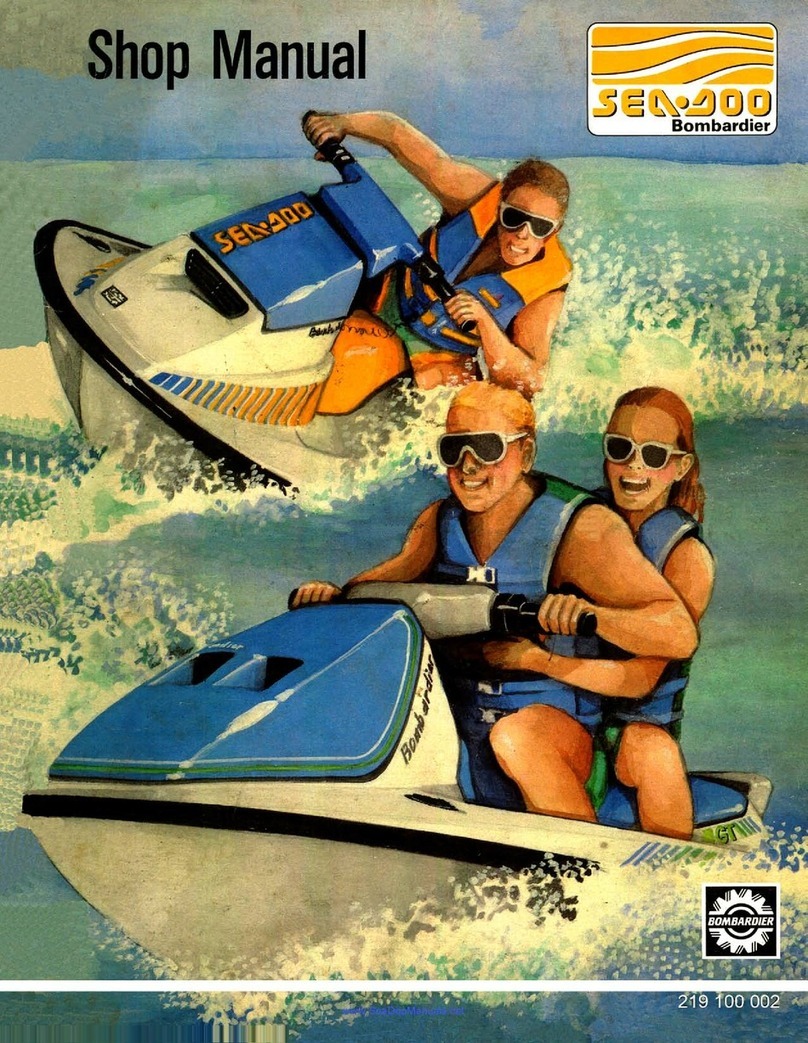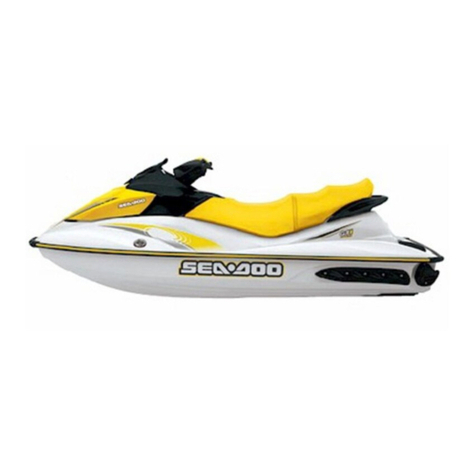Bonefish Bohemian 17 User manual

1
OWNERS AND
OPERATORS MANUAL

2
ERS ORIENTATION
WELCOME
Congratulations on the purchase of a new boat. This manual and its periodic updates posted on
the website (“manual”) is intended to help you and all users of the boat understand how it works,
how it should be maintained, as well as make your time on the water safe and enjoyable. We
manufacture multiple boat models ranging from small unpowered crafts to large multi-engine
offshore fishing vessels. Consequently, this manual is necessarily generic in nature, and may
not cover specific items that are unique to your model. Likewise, this manual may address items
or features that are not included in your boat. In addition, your boat incorporates features and
accessories that were not built by us (e.g., stereo equipment, jack plates, shallow water
anchors, lighting, steering systems, electronics, fuel tanks and motors) and are therefore not
addressed in this manual. The suppliers of these “third party” items provide their own owner’s
manuals which are available directly from them (though we have attempted to supply them to
you at the time of purchase). You must read the information in this manual and the third-party
manuals completely and have a thorough understanding of all component systems and their
proper operation before operating your boat. In addition, the “third party” items have their own
warranties that is different from what we provide.
All boats are not the same, and operation of a boat on water is nothing like operating a vehicle
on a roadway. Roads are relatively smooth and level. Water isn’t. In fact, it’s constantly
changing. Tides ebb and flow. Waves increase and decrease size and distance. Obstructions
appear out of nowhere. The same body of water has differing conditions all day long and from
day to day. As a result, not all boats should be used on all waterways at all times. They have
intended uses and associated limitations. For our boats, the maximum limits are as follows:
INSHORE
Within 1.5 Miles of Shore.
No more than 1.5’ Seas
No more than 5kt Winds
NEARSHORE
Within 20 Miles of Shore.
No more than 3’ Seas
No more than 10kt Winds
OFFSHORE
Within 60 Miles of Shore
No more than 5’ Seas
No more than 15kt Winds
Bohemian 17 Ozona 25 Tortuga 30
Diavolo 20 Malvado 26
Hill Tide 22 Sabalo 23
Calusa 24 Sabalo 27
Sabalo 21
These distances, winds and sea heights are NOT safe or permissible in all circumstances, at all
speeds, and under all loads. These are maximum limitations for minimally loaded vessels at
safe operating speeds captained by experienced operators. As the boat’s operator, you are
responsible for determining what you and the boat are safely capable of in all load, speed, sea
and weather conditions. As winds and/or sea conditions deteriorate, your decisions must always
be adjusted to maintain safety and control. Regardless, the above chart contains absolute
limitations on our boats that should never be exceeded regardless of experience, speed or load.
OPERATOR RESPONSIBILITIES
As the operator of a boat, you are responsible for:
Reading, understanding and complying with this manual, as well as the express limited
warranty applicable to your boat. Warranties are posted on the web site of the brand of
boat you purchased.
Being reasonable. We don’t expect you to be perfect, so please do not expect that from
us. Our boats are hand built by multiple people who strive for perfection but don’t always

3
achieve it. So, if you have an issue, please do not take it personal. We didn’t single you
out nor are we trying to hurt you in any way. Just let us know and, when applicable, give
us a reasonable opportunity to correct it.
Studying and continuing to refer to this manual and all instructions for your boat and any
third party products associated with your boat.
Being familiar and complying with all local and national regulations applicable to the
transportation and operation of the boat.
Examining your boat and confirming that all systems are working properly at the time of
delivery and prior to each use.
Scheduling regular maintenance for your boat and associated third party products.
Completing a boater safety course approved by the Florida Fish and Wildlife
Commission and currently found at: http://www.myfwc.com/boating/safety-
education/courses/ (“Safety Course”).
Complying with the U.S. Coast Guard’s most current Navigation Rules
(https://www.navcen.uscg.gov/pdf/navrules/navrules.pdf) and Navigation Aids
(http://uscg.mil/d13/docs/usaidstonavigationsystembooklet23dec03.pdf).
The contents and requirements of the Safety Course and Navigation Aids are incorporated into
and are a part of this Manual.
Registration and Numbering
US law requires that all undocumented vessels equipped with propulsion machinery be
registered in the state of principal use. A certificate of number will be issued upon registering the
boat. These numbers must be displayed on your boat. The owner/operator of a boat must carry
a valid certificate of number whenever the boat is in use. When moved to a new state of
principal use, the certificate is valid for 60 days. In order to be valid, the numbers must be
installed to the proper specifications. Check with your dealer or state boating authority for
numbering requirements. The Coast Guard issues the certificate of number in Alaska; all others
are issued by the state.
Insurance
In most states the boat owner is legally responsible for damages or injuries he or someone else
operating the boat causes. Responsible boaters carry adequate liability and property damage
insurance for their boat. You should also protect the boat against physical damage and theft.
Some states have laws requiring minimum insurance coverage. Contact your dealer or state
boating authority for information on the insurance requirements in your boating area.
Reporting Boating Accidents
All boating accidents must be reported by the operator or owner of the boat to the proper marine
law enforcement authority for the state in which the accident occurred. Immediate notification is
required if a person dies or disappears as a result of a recreational boating accident. If a person
dies or there are injuries requiring more than first aid, a formal report must be filed within 48
hours. A formal report must be made within 10 days for accidents involving more than $500.00
damage or the complete loss of a boat. If you need additional information regarding accident
reporting, please call the Boating Safety Hotline, 800-368-5647.
Safety Standards
To meet required standards some of the safety equipment on your boat must be Coast Guard
approved. “Coast Guard Approved Equipment” has been determined to be in compliance with
USCG specifications and regulations relating to performance, construction or materials. The

4
equipment requirements vary according to the length, type of boat and the propulsion system.
Some of the Coast Guard equipment is described in the Safety Equipment chapter of this
manual. For a more detailed description, obtain “Federal Requirements And Safety Tips For
Recreational Boats” by contacting the Boating Safety Hotline 800-368-5647. Some state and
local agencies impose similar equipment requirements on waters that do not fall under Coast
Guard jurisdiction. These agencies may also require additional equipment that is not required by
the Coast Guard.
COMMON NAUTICAL TERMS
If you’re new to boating, take the time to familiarize yourself with the terminology associated
with this activity. It will aid in your understanding of this manual, as well as some of the laws
applicable to the operation of your boat. While not exhaustive, this is a list of commonly used
terms and their meaning:
Abeam - A line perpendicular to a boat’s keel.
Access Plate - A removable, watertight cover that provides quick entry to enclosed areas
for maintenance or visual inspection.
Aft - Toward the rear or stern of boat.
Beam - The greatest width of a boat.
Bilge - The lower interior area of the provide access below hull
Bow - The forward/front part of a boat.
Bow Eye - A u-shaped hull fitting used to attach the trailer winch to the boat
Bulkhead - Vertical partition in a vessel fastened inside the hull.
Chine - Meeting juncture of topside and bottom of boat.
Cleat - Deck fitting with arms or horns of a boat on which lines are fastened.
Deck - Upper structure which covers the hull.
Draft - Depth of water required to float a boat.
Fathom - A depth measurement equal to six feet.
Freeboard – Distance between topside and the deck.
Gunwale or Gunnel - Meeting from deck or cockpit junction of hull and deck.
Hatch - An opening in the deck.
Head - A toilet or toilet area in a boat.
Headroom - Vertical distance between the deck and cabin or canopy top.
Hull - The basic part of the boat.
Keel - The major longitudinal member of a hull and the lowest external portion of the hull.
Knot -Unit of speed in nautical miles.
Lee or Leeward - The side that is sheltered from the wind.
List - The tilt or lean to one side.
Port - The left side of the boat when facing the bow.
Scupper - Holes permitting water to drain overboard.
Sheer - Curve or sweep of the deck as viewed from the side.
Starboard - The right side of the boat when facing the bow.
Stern - The rear end of a boat.
Stringer - Longitudinal members that provides structural strength.
Wake - The track or path left in the water by a moving boat through the water.
Windward - Toward the direction from which the wind is blowing against the deck.

5
MAJOR BOAT OPERATIONS AND SYSTEMS
Now that you have some basic terms under your belt, let’s look at some of the basic boat
functions you need to understand and have command of to safely operate your boat.
Trim
Most outboard boat models are equipped with power
tilt and trim mechanisms. The purpose of power tilt
function is to raise the engine for launching, loading
or trailering your boat. The power trim function may
be used to adjust the boat’s planing performance
and running attitude. Trim refers both to the weight
distribution inside the boat and the angle of thrust of
the drive unit. The angle of thrust of the drive unit
forces the bow up or down. The proper trim angle will
vary depending on the load and weight distribution in
your boat. If the drive is trimmed to far in, it will drive
the front of the boat down into the water causing a
condition known as “bow steer” where the outboard
loses its ability to effectively control the direction of
the boat. If trimmed to far in in waves, you run the
risk of driving the bow beneath the water (also known as “stuffing” a boat). Stuffing a boat can
cause harm, damage and could even result in sinking. If the drive is raised too far, you will
cause the propeller to "ventilate" or “cavitate”, resulting in a sudden increase in engine RPM as
well as a loss of speed and control. If this occurs, immediately reduce engine speed and lower
the drive until the condition is corrected. In certain circumstances, improper trim and/or weight
distribution can cause a boat to rotate or “spin out”. Always distribute weight evenly side to side
and mostly to the rear of your boat. Never allow persons to sit in any area other than those
designated specifically for seating. Finally, never exceed the maximum weight printed on the
capacity sticker inside your boat.
Propeller
The propeller converts the engine’s power into thrust to propel the boat. The right propeller for
any boat in a specific application is one that allows the engine to turn up to its full rated RPM,
but no more. It is necessary for the engine to turn to full rated rpm in order to develop full rated
power. If the boat is used for more than one type of activity, fishing and water skiing for
example, the prop can only be optimized for one situation. Since a spare propeller is an
excellent safety item, the purchase of a second propeller which is more efficient for another
application is not all “added expense”. Propellers are identified by two numbers such as 14 x 17,

6
and a material identification, such as aluminum or stainless steel. The first number is the
diameter and the second is the pitch. The diameter is the distance across the circle swept by
the extreme tips of the propeller blades. The term pitch comes from the old screw analogy used
to approximate propeller action. This analogy says that a propeller screws itself through the
water much as a wood screw works itself into soft pine. The pitch is the angle of the blades
expressed in the theoretical distance a propeller would travel in each revolution. In the above
example the propeller would advance 17” on each revolution. In reality, the propeller actually
pushes the boat forward less distance than its pitch. The difference between the pitch and the
actual distance traveled is called “slip”.
Propulsion
The engine manufacturer supplies all vital information concerning your engines in the operation
and maintenance manuals. Details of important engine maintenance schedules, lubrication
system, cooling system and engine alert systems are outlined in these manuals. Your
familiarization with this engine reference material will result in the proper usage and service that
is essential for safe and enduring engine performance.
Engine Systems
Do not attempt to service any engine or drive component without being totally familiar with the
safe and proper service procedures. Certain moving parts are exposed and can be dangerous.
Throttle/Shift Control
The engines throttle/shift functions are located at the helm
station. The single lever used on each control box activates the
gear and throttle actions.
Neutral Safety
Your outboard powered boat contains a neutral safety switch
which prevents the engine from being started in gear. When
starting your engine the control lever must be placed in the
neutral/middle position. When functioning properly, this
mechanism does not allow the engine to start when the control is
not in the neutral position.
Shift
After your engine is started simply move the control lever in to the
forward detent position. To place the engine in reverse, move the
control lever backwards to the reverse detent location.
Remember that propellers are designed for maximum forward
thrust so reverse thrust will not be as efficient.
Throttle
Forward Throttle: To engage the throttle mechanism while in forward gear move the lever
forward past the detent in a controlled motion. This motion will begin to increase engine RPM
which will cause the boat to move forward.
Reverse Throttle: To engage the throttle mechanism in reverse, continue to move the lever
forward (back or aft) past the detent in a controlled motion. This motion will begin to increase
engine RPM which will cause the boat to move backwards.

7
Neutral Throttle: To engage the neutral throttle function on your control depress the neutral
lockout button located at the center of the control lever’s pivot point. While fully depressing the
button inward move the control forward or reverse to activate the throttle.
Stopping
There are no brakes in a boat. It’s nothing like an automobile. As a result, you have to be more
diligent when operating a boat than when operating a car. You have to anticipate and avoid
collisions because you do not have the option of braking at the last second. When docking and
performing slow speed maneuvers, you can reverse the shift mechanism. This change in prop
direction will provide some “braking action,” and slow the boat.
Control Cables
If your throttle or shift cables need replacing use the same style and length as the original
equipment.
Emergency Stop Switch
Your outboard powered boat is equipped with an emergency
stop or “kill” switch. This is a safety feature that, if used
properly, will shut the engine(s) down if the operator leaves
or falls from the helm position. The standard system consists
of a shut-off switch, switch clip, lanyard and lanyard clip. The
lanyard clip
should be
attached to the
operator. If a situation arises where the boat
should stop, a pull on the cord to release the clip
from the shut-off switch will shut down the
engine(s). To reset the emergency stop switch,
simply reinstall the switch clip. YOU MUST WEAR
THIS IMPORTANT SAFETY DEVICE AT ALL
TIMES WHEN OPERATING THE BOAT. The
danger of falling out of a running boat is REAL.
This is a link to a story regarding former Miami
Dolphin football player Robert Konrad who fell off of his boat when fishing approximately 10
miles offshore: http://abcnews.go.com/US/video-shows-miami-dolphin-rob-konrads-shock-
learning/story?id=29202745. Due to his superior physical condition, Mr. Konrad was able to
swim for 16 hours in the dark and in exceptionally cold water. Most people can’t do this. WEAR
THE KILL SWITCH. We offer wireless kill switches as an option so if there is any reservation
about wearing a traditional switch lanyard, ensure that you obtain and use a wireless alternative.
Steering
Steering systems require regular preventative maintenance for
continued safe and reliable operation. For hydraulic helms, the oil
level in the helm pump must be maintained within acceptable
operating levels. A low oil level will cause air to be introduced
into the steering system and result in unresponsive steering. The
oil level should always be within 1/2 inch from the base of the fill
hole located on the front top portion of the helm pump or
remotely on the console. Check the entire steering system
regularly for oil leaks (no less than every 6 months). Unobserved leaks over a period of time will
result in unresponsive steering or loss of steering. Any moving mechanical linkages, sliders, etc.

8
should be greased as needed with high quality marine grease approved by the steering
manufacturer. Refer to the manufacturer’s steering manual for specific recommendations and
additional maintenance. Any slow or sudden change in the “feel” of your steering system
indicates an immediate need for a thorough inspection. All repairs and replacements to steering
systems should be made by us or an authorized steering system dealer.
Trim Tabs
Most outboard equipped boats are equipped with an
adjustable trim tab. The tab planes mounted on the transom
of the boat are actuated by an electric ram piston. Two
switches at the helm operate the trim tabs. The switches are
labeled "bow up-bow down" and correspond to the side of
the boat the switch is closest to, although the tab on the
opposite side of the boat causes this motion. The trim tabs
should be adjusted to balance the steering at the speed
which you travel most frequently. Variations in speed, boat
load or changes in the engine trim will cause the steering to
pull in one direction. If the boat pulls to the left adjust the
trim tab to the left and vice-versa. Always remember to fully retract the trim tabs prior to putting
the boat on a trailer. Stepping on the trim tab plane may cause damage to the unit
or result in injury. See the trim tab owner’s manual for complete maintenance information.
Jack Plates and Scissor Jacks
Your boat may be equipped with a jack plate or a scissor jack (also known as
a Porta-Bracket). These devices raise and lower your motor in a vertical
fashion, instead of at an angle like the motor’s power tilt. These are excellent
tools for reaching shallow water fishing grounds, but are intended for straight
line and slow speed operation only. They are dangerous at fast speeds and
especially in turns. If one of these devices is used to raise the motor to a
point where the anti-cavitation plate on the lower unit is higher than the
bottom of the boat, then then you should immediately reduce engine speed
and lower the drive until the condition is corrected. If you don’t, there
will be an insufficient amount of motor below the waterline which
could (In addition to causing motor damage) result in your boat
sliding or even spinning out of control. To minimize the risk of a slide
or spin, you should always distribute weight evenly side to side and
position the majority of weight in the rear of your boat. Never allow
persons to sit in any area other than those specifically designated for
seating, and never exceed the maximum weight printed on the
capacity sticker inside your boat.
BOAT HANDLING
Before taking on passengers or a long trip, you need to learn how to handle and obtain the best
performance for your boat. The best way to do that is to practice and experiment with just you
on board. After several hours of operation you should experiment with throttle settings to
determine the most comfortable and economical throttle range for your typical loading
conditions. We suggest that you make a speed/RPM chart in order to obtain the most
economical operation. Operate the boat at various speeds and check the fuel consumption at
each speed. Determine the amount of operating time remaining when the fuel gauge drops to

9
the low fuel level. Make a log of this information and have it available when using your boat.
Other statistics you should determine include the following:
Minimum and maximum speeds for effective and safe steering.
Turning radius at different speeds.
Response to steering at low speeds.
Response to steering at high speeds.
Control of the boat using both engines in close quarters.
Time and distance to bring the boat to a stop at different speeds.
BOAT PERFORMANCE
Maximum performance is dependent on many factors and cannot be guaranteed in every
condition. These factors vary with changing conditions. These factors include:
Hull Design
The boats we manufacture are all planning hulls. This hull type has a v-shaped bottom that is
designed to glide on the surface of the water (i.e., plane) as the boat gains speed. Most
powerboats have this type of hull because they require less power to attain higher speeds. In
the Bonefish brand we offer a variant of a planning hull known as a stepped hull. Steps are
essentially elevation breaks in the hull bottom that create multiple running surfaces. As the boat
increases speed, the hull rides on these surfaces, with the area that is in contact with the water
moving progressively aft and reducing in size. This results in more speed with less power than a
conventional planning hull. Stepped hulls aren’t for everyone. They demand a higher level of
skill and attention by their operator. They are NOT for novice boat operators. They have
limitations in trim capability that don’t allow operators to dictate the boat’s attitude (i.e., “fly” the
boat) with complete autonomy/independence using tabs and engine trim (They tend to ride at a
particular attitude based upon the hull’s design with reduced ability to effect pitch and yaw).
Stepped hulls are also much more sensitive to weight. Heavier weight greatly effects the ability
of a stepped hull to reach its designed efficiency. Weight additions (particularly up high) also
present the risk of excess chine immersion (sinking the step vents below the water line) which
blocks air flow to the steps and can result in a low-pressure spike that causes a loss of
directional control. For these reasons, the operator of a stepped hull must pay close attention to
the weight limitations provided with the boat. To the extent weight is added to the boat, you
must distribute it evenly from port to starboard, mostly in the stern and as low as possible in the
hull. If a tower or other elevated driving station is offered on a stepped hull boat, it is the only
elevated station we believe is safe for a recreational boater. Do not purchase a tower or other
elevated driving station from someone other than us for your step bottom boat. Metal fabricators
know absolutely nothing about hydrodynamics or what impact their creations can have on a
boat’s center of gravity. They create unnecessary risks for the operator. Considerable time
should be spent by the boat’s operator learning the boat’s handling characteristics and
experimenting with weight distribution prior to taking passengers onboard and being responsible
for their safety. There is absolutely no substitute for time behind the wheel.
Engine Efficiency
Engines operate most efficiently at the RPM confirmed in the engine operating manuals,
assuming your boat is equipped with the correct engines, the engines are properly tuned and
the drive systems are in good condition. Efficiency will decrease if normal care and maintenance
is not performed. If engines are neglected power will drop and speed will decrease. In addition,

10
TheBottomFigureisCorrect
ThisisIncorrect
expensive repairs may become necessary. Be sure to follow all instructions in the engine
operation manuals.
Weather Conditions
Weather conditions affect engine performance. Barometric pressure and humidity both influence
horsepower. A change of weather could cause a 10% loss in horsepower on a hot day.
Marine Growth
Maximum performance is obtained only when your hull bottom is clean. Marine growth on the
bottom of the boat will increase resistance and decrease speed. These conditions will also
increase fuel consumption.
Sea Conditions
Sea conditions vary a boat’s performance greatly. You will need to slow down and operate the
boat more conservatively in higher seas.
Load and Load Distribution
A drastic change will be noticed when gear, equipment,
passengers and fuel are added to the boat. The smaller the
boat, the more drastic the change. This extra load and its
placement greatly affect performance and handling. Water
accumulation in the bilge and/or baitwells also impacts
performance. Keep the bilge dry
and drain all wells when not in
use.To minimize the risk of a
slide or spin, you should always
distribute weight evenly side to
side and slightly more in the rear
than the front. Never allow
persons to sit in any area other
than those specifically designated
for seating, never let them stand
when the boat is underway and never exceed the maximum
weight printed on the capacity sticker located inside your boat. It
will cause the boat to become tippy and unresponsive. This video
demonstrates what we mean (forgive the colorful language – it’s not our video):
https://www.facebook.com/BonefishBoatworks/videos/1596884063692576/?hc_ref=ARQD5Jzjsj
dNO_YLp4b1BkfC2xLJ4KnFQy1MK99PXN6nQOW412bFkcazFrOej_VUiOo&fref=nf. Trust us,
this can happen on your boat too. Water is not land and boats do not respond to weight the
same way a vehicle does. Don’t think you “know” what to expect. Maintain a safe distance.
Practice operating your boat and take a safe boating or captain’s course. They’re worth the time
and money. They may save a life in addition to preserving your property.
HAZARDS AND WARNINGS
This manual includes several safety instructions to assure the safe operation and maintenance
of your boat. These instructions are in the form of DANGER, WARNING, CAUTION and LEGAL
statements. These hazard warnings shown below are used in this manual to alert you to
potentially dangerous situations that can lead to breaking the law, product damage, personal
injury and/or death. We urge you to observe these warnings and to comply with all safety
recommendations.

11
DANGER
WARNING
CAUTION
LEGAL
Loading and Horsepower Capacity
As already discussed, overloading and
improper load balancing causes many
boating accidents. Boaters must know the
amount of weight on board and evenly
distribute that weight within the boat. There
is a capacity label affixed in the boat. Know
your boat’s maximum capacity and
maximum horsepower and never exceed
those limits.
GENERAL BO
ATING
INFORMATI Turning
Turning a boat in any condition
other than calm seas with no wind
and a single occupant with the
lower unit of the motor fully in the
water can be dangerous. Turns
can result in shifting or throwing
persons or cargo overboard…or
even worse, capsizing. Extreme
caution must be exercised when
executing turns any faster than
minimum planning speed (typically
around 20 mph for vessels over
16’ in length) and should be as
wide as possible to avoid slipping
on the water’s surface or hooking
an edge that could cause a boat to turn abruptly with a violent change in

12
TurboSwin
g
TowBridle
direction. You should have one hand on the wheel and the other on the throttle at
all times so that you can quickly make adjustments to both while executing the
maneuver. Never jerk the steering wheel. A well-executed turn requires a steady
hand. Never attempt a turn if: (i) the lower unit of the motor is not fully under
water; (ii) you are traveling faster than minimum planning speed; (iii) the boat is
overloaded; (iv) the boat’s load is not evenly distributed from side to side and
positioned mostly in the rear of the boat; or (v) passengers are not fully seated in
designated seating areas.
Skiing, Wake Boarding, Surfing, Knee Boarding and Similar Water Sports
Our boats are all equipped with outboard power. As a result, extra caution must
be used when participating in water sports. If your
boat did not come equipped with a ski pylon, then
you must use a Turbo Swing or tow bridle when
pulling skiers, wake boarders, knee boarders,
tubers and other water sport participants. A
distance of 100 feet from the boat’s propeller is
the bare minimum distance you should maintain
when engaging in water sports activities. Never
allow wake surfing or skurfing (close to boat slow
speed board planning) behind an outboard
powered boat. The participant is at risk of carbon
monoxide poising as well as serious injury or
death if they fall onto or near the spinning
propeller. An outboard creates significant suction
aft of the motor that it can pull a person into the
spinning propeller or even under the boat. Finally,
the most important thing to remember is to keep a
safe distance from objects in the
water that could impair or alter the
performance of the boat or the
water sport participant (e.g.,
shallow water, docks and other
boats). You must employ a human
spotter to watch the water sport
participant(s) at all times and
communicate with the boat’s
operator. Also, when retrieving
people, turn the motor off and pull
them in by the towline.
Propellers
It should go without saying that propellers on a boat are exceptionally
dangerous…but we’re saying it anyway. It’s a large metal hub with sharp blades
spinning rapidly. Think of it as an unguarded food processer blade. Knowing this,
always exercise extreme caution and good judgment regarding propellers and at
a minimum, follow these simple rules:

13
1) Never allow people to sit on the deck
of the boat when the propeller is
engaged (Any deck mounted seat
backs provided by Bonefish are for
use at rest only);
2) Turn off your motor whenever you
are around swimmers;
3) Turn off your motor if anyone is on your boat in any a position other than fully
inside the boat in a designated seating area;
4) Turn off your motor if anyone is using or is about to use a swim ladder; and
5) Advise all occupants of the dangers associated with a propeller on each trip.
Fueling
Safety during fueling requires CAUTION and COMMON SENSE. Observe the
following precautions carefully:
Check your engine manual to confirm the type of fuel and oil specified by the
manufacturer. Do not use fuel containing alcohol. Alcohol in fuel will
deteriorate the rubber material used to make up your fueling system.
Have an adequately charged fire extinguisher nearby.
Observe all safety regulations for the handling of fuel.
Extinguish cigarettes and all other lighted materials.
Before fueling shut down all engines.
Before fueling close all ports, hatches, windows, and engine compartments to
prevent fumes from accumulating in closed areas.
Before fueling turn battery select switches to the “OFF” position to insure that
all lights, electronic equipment, etc. are off.
Keep the fuel supply nozzle in contact with the fuel tank opening to prevent
any static sparks.
Do not over fill tank. Wash and clean-up any spilled fuel. Secure the fuel cap
and check fuel lines and connections for leakage.
Dispose of rags or sponges
used for clean-up on shore.
Do not store these clean-
up rags in the boat.
After fueling ventilate all
ports, windows, hatches
and other closed areas.
Conduct a “sniff test” to
make certain all fumes are
vacant before using the
battery select switches.
Carbon Monoxide
Exhaust fumes contain carbon monoxide (CO), an odorless and colorless gas.
Carbon monoxide is poisonous and a health hazard that can be fatal if breathed
over an extended period of time. Symptoms of CO poisoning can include:
dizziness, nausea, headache, sleepiness, vomiting, throbbing in temples,

14
muscular twitching and the inability to think clearly. If you or anyone else
experience these symptoms immediately get away from fumes and into an area
where plenty of FRESH air. If symptoms persist seek medical attention. Carbon
Monoxide (CO) is the gas formed by the combination of one molecule of carbon
and one molecule of oxygen. Chemists refer to it as CO. The boat operator
should be aware that CO is emitted from any boat’s exhaust. You are susceptible
to CO while operating, mooring, and or anchoring in an area containing other
boats emitting engine exhaust. An operator, likewise, needs to be aware of the
consequence of his actions on other boats. Of primary concern is the operation
of an auxiliary generator with boats moored alongside each other. When
operating center console or dual console boats at cruising speeds, slow speeds,
or dead in the water with canvas tops, side curtains and or back curtains in place,
be aware of engine exhaust to ensure that emissions do not accumulate in the
boat’s interior. Maintain proper ventilation by adjusting canvas enclosure.
Discharge Regulations
The Federal Water Pollution Control Act prohibits the discharge of oil or any
other hazardous substances which may be harmful into the U.S. navigable
waters. The US Coast Guard requires any vessel 26 feet or greater display a
placard in a prominent location notifying the crew and passengers of discharge
restrictions. Each placard must be at least nine inches wide and four inches high,
made of a durable material and printed with letters that are at least 1/8 of an inch
in height. Violators are subject to a penalty of $5,000. The placards are available
online and in most boating supply stores. A sample placard appears below:

15
Disposal of Plastics and Other Garbage
The US MARPOL ANNEX V is the Act to prevent pollution from ships and other
vessels. Federal regulations prohibit the discharge of plastic garbage anywhere
in the marine environment. Plastic includes but is not limited to: synthetic fishing
nets, ropes, lines, straws, six pack holders, Styrofoam cups and lids, bottles,
buckets and plastic bags. These regulations also restrict the disposal of other
types of garbage within specified boundaries from shore. The following plaque
will help you determine the specific distances offshore that certain garbage is
permitted.
BEFORE HEADING TO THE WATER
Federal and State laws require power boats and trailers to be registered in the state where they
are primarily used. Registration numbers and validation stickers must be displayed according to
applicable regulations. The registration certificate for the boat must be on board when boating.
The boat Hull Identification Number (HIN) is required on the registration form. The “Hull
Identification Number” is located on the transom of your boat, typically on the starboard side.
TRAILERING YOUR BOAT
Never allow passengers to ride in the boat while
trailering. Check brakes prior to leaving. Drive as steady
as possible and avoid sudden jerks. Anticipate stops to
make them smooth. Road trips call for occasional stops
to make sure the trailer is still secured properly. The
adjustment and balance of your boat on the trailer
determines how easily your boat may be transported.
The tongue weight on the hitch ball should be 5-10% of
the total weight of your boat, motor and trailer. Tail-heavy
loads cause swaying while trailering. The rollers and/or
bunks of your trailer should be adjusted so that the
weight is distributed evenly across the stern and forward
throughout the keel sections. Practice maneuvering the trailer. The trailer always backs in the
opposite direction of the vehicle: To maneuver the trailer, turn the steering wheel in the direction
you want the trailer to go. This is a good checklist to follow when trailering your boat:
Consult your state laws as to brake and axle load requirements.
Check brakes for proper operation and fluid level prior to departure on each trip.
Check springs and undercarriage for loose parts.
Check tires for proper inflation. Under-inflated tires heat up rapidly and tire damage or
failure is likely to occur.
Wheel bearings and lug nuts should be checked before each trip.
Your boat should be fastened to the trailer by a line from the bow eye to the winch line
plus a bow tie-down to the winch stand or trailer tongue. The stern of your boat should
be tied down to the trailer from the stern eyes.
Check to be sure the tail lights and turning signals work prior to towing.
Bimini tops are not designed to stay on boats at highway speeds.
Before towing, take down the Bimini top, if equipped.
Carry a spare tire for both your trailer and your towing vehicle along with sufficient tools
to change them.
Be sure all lids, doors, and the engine cowling are latched securely before trailering.
On extended trips, carry spare wheel bearings, seals and races.

16
While traveling, check the wheel hubs every time you stop for gas or refreshments. If the
hub feels abnormally hot, the bearing should be inspected before continuing your trip.
When rounding turns on highways or streets, do not cut corners. Also, go slowly over
railroad tracks.
Before backing your trailer into water, disconnect the light plug from the towing vehicle to
reduce the likelihood of blowing out lights when they become submerged.
PRIOR TO LAUNCHING YOUR BOAT
Below is a list of items to check and perform prior to placing your boat
in the water:
Check all gear and replace if necessary
Check thru hull fittings for cleanliness, damage and tightness.
Check prop installation and tightness.
Clean battery terminal posts with a wire brush or bronze wool.
Install batteries, attach cables and tighten. Apply grease to post
to exclude air and acid. Check all wire connections for contact corrosion and tightness.
Check hull valves for easy operation and for condition of hose.
Check operation of bilge pumps in manual and automatic modes.
Check shower sump pump. Check operation of all DC circuits if applicable.
Check the hose and lines on the fresh water system, install drain plug and close drain
valves.
Perform maintenance on engines according to the manufacturer’s manuals prior to
returning them to service.
Fill fuel system and thoroughly check out fuel system including lines, fittings,
connections, valves and filters for leaks.
Check operation of toilet (reference manufacturer’s manual).
Check all engine and steering control cables and linkage for operation.
Lubricate cables and linkage as necessary.
Fill fresh water system and check for leaks.
Check safety equipment including flares, fire extinguisher and first aid kits. Replace
items as necessary.
PRE-START CHECKLIST
The following checks are essential to safe boating and should be performed before ever starting
the engine. Get in the habit of performing these checks in the same order each time so that it
becomes routine.
Ensure weather conditions are (and are predicted to remain) conducive to safe
operation. Never operate your boat during small craft advisories or worse weather
conditions.
Check that the required safety equipment is on board and in good condition.
Check that the fire extinguisher is fully charged, and be sure that you are familiar with its
proper use.
Check that no fuel, oil or water is leaking.
Check all hoses and connections for leakage and damage.
Check that the hull drain plug is in place and securely tightened before putting the boat
in the water.
Check that battery terminals are clean and tight.

17
Check that all navigation lights operate properly.
Check that fuel and oil levels are adequate. Always carry more fuel than you anticipate
using, in case you are forced to change your plans for weather or other reasons.
Check that throttle/shift control is in neutral.
Check that the steering system operates properly.
Check that all required maintenance has been performed.
Check to ensure the anti-cavitation plate on the lower unit of the motor is lower than the
water line.
Verify that all weight loaded into the boat is distributed evenly from side to side and
positioned mostly to the rear of your boat.
Do not allow people to sit in any area other than those specifically designated for
seating.
Verify that the combined load of passengers and cargo do not exceed the maximum
weight printed on the capacity sticker inside your boat.
LAUNCHING
Be sure to look in all directions before backing down a boat ramp.
You’ll need to verify that the drain plug is in and that there are no
stern straps holding the boat to the trailer before backing into the
water. While it may be possible to launch your boat without the use
of a concrete ramp, be sure that your chosen spot is legal and
won’t result in your vehicle or your trailer becoming stuck in sand
or mud. After backing down the ramp stop backing into the water
once the boat begins to float/lift off of the trailer. While there is no
hard and fast rule for all trailers on all ramps, submerging the lower
half of the trailer fender is usually pretty close. Make note of the
correct depth for future reference.
Before exiting the vehicle to launch
the boat be sure the vehicle it is
turned off and the parking brake is engaged. For manual shift
vehicles, be sure to also leave the vehicle in gear. Take a close
look at these photos. Clearly these boaters didn’t make sure their
vehicles were in park and the break was fully engaged. Don’t let
this happen to you. Another common mistake is launching the boat
before tying a line to the forward and stern cleats. If you do that,
you’ll have to depend upon the generosity of a fellow boater, an
incoming tide or your swimming proficiency to retrieve your boat.
NON-RAMPS
You can, in some situations, launch and retrieve a boat safely without
using a traditional paved boat ramp. If you intend to do so be aware
that it can be very difficult. Traction is typically lost on loose sand and
rocks. Use of a four wheel drive vehicle is highly recommended.
Ensure that you are not on private property without permission or on
government property that is restricted in use. Finally, be sure to check
the tides. I’m sure this spot was perfect when he launched the boat,
but it obviously isn’t now that it is time to go home.

18
IMMEDIATELY BEFORE AND AFTER LAUNCHING
Before releasing the boat from the trailer and/or the dock
inspect the boat for all sources of possible leaks from stem
to stern (including the bilge area). Verify that all engine and
steering control cables and linkage are lubricated and have
been properly maintained for safe operation. Ensure all
motor bolts are tight and ready for
use. If any of these critical items are
not functioning in accordance with
the manufacturer’s design
immediately contact a service facility
to schedule a thorough inspection
and service. Always operate your
engine(s) as directed in
manufacturer’s manual.
RETREIVING THE BOAT FROM THE WATER
If you were paying attention when you launched the boat,
you’ll know how deep to submerge the trailer in order to pick
the boat back up (assuming the tide hasn’t changed too
much in the meantime). Your trailer should be equipped
with a safety chain. You should hook the chain to the bow
eye every time you pull the boat anywhere…especially out
of the water. This one is
worth repeating because so
many people mess it up.
ALWAYS USE A SAFETY
CHAIN WHEN TRAILERING
A BOAT. Winch straps are
pretty strong, but they fray
and decay over time. If
these guys had used their
safety chains they could
have avoided some very
expensive fiberglass repairs.
STERN STRAP THE BOAT WHEN IT IS ON A TRAILER
In addition to being the law
in most states, using a
stern strap on your boat
when it is on a trailer is
just good common sense.
Even people with a
rudimentary understanding
of physics realize that a boat will not stay on a trailer during a
sharp turn or over a large bump in the road if the stern is not

19
strapped down. What usually happens is the strap is broken or forgotten and people “risk it”.
They’re often reminded the hard way of what happens if you chance it. Hopefully the folks in
these photos have learned their lesson.
TRAILER MAINTENANCE
Trailers don’t maintain themselves. Read your owner’s
manual and contact the manufacturer if you don’t have one
or it’s misplaced. Follow their guidelines religiously. At a
minimum, you should check for sufficient grease in the
hubs every time you move your boat. Bearing buddies are
available at trailer and marine supply stores to make it
easier to apply grease to trailer hubs. You should also
make a visual inspection of your suspension to see if there are any
loose fittings. Your axle(s) should be serviced and properly lubricated,
and all fasteners checked and tightened at least once a year. These
guys failed to maintain their trailers and it
caused the hubs to rot off of the axle. They’re
lucky that this is all that happened. Imagine if
they had been traveling 60mph in rush hour
traffic. Significant property damage and
personal injury would have resulted. Trailer
maintenance is serious business.
OPERATING YOUR BOAT
Leaving/Approaching the Dock
Unlike an automobile, the stern of your boat reacts first when turning. A turn to the right will
swing the stern to the left and vice-versa. Remember that turning your boat away from an object
such as a dock will tend to swing the stern toward that object.
Rules of the Road
Boat operation is governed by the International Regulations for the Prevention of Collisions at
Sea 1972 (72 Colregs) and the 1980 U.S. Inland Navigation Rules (Inland Rules), also known
as the Rules of the Road. You may also be responsible for any local regulations (rules that
elaborate on minor details of the Inland Rules). The boundaries between the 72 Colregs and the
Inland Rules are indicated by a dashed magenta line (demarcation lines) on navigational charts.
We have included a portion of the Rules of the Road in this manual, but they are not intended to
be your sole source of information.
Overtaking
The boat that is overtaking one ahead of it is the
burdened boat and must make any adjustments
necessary to keep out of the way of the privileged boat.
Meeting Head-On
Neither boat has the right-of-way in this situation. Both
boats should decrease speed, should turn to the right,
and pass port-to-port. However, if both boats are on the

20
left side of a channel, each vessel should sound two short horn blasts and pass starboard to
starboard.
Privileged Boats
Privileged boats have right-of-way and can hold course and speed. Sailboats and boats paddled
or rowed have the right-of-way over motor boats. Sailboats under power are considered
motorboats. Small pleasure craft must yield to larger boats. However, you must use common
sense when applying these rules. Not everybody follows the rules. Boating is no different than
driving. You must be defensive. Anticipate potential collisions and avoid them. One area often
neglected by power boat operators is the danger associated with slowing down or stopping.
Boat’s don’t have taillights, so you must be aware of and avoid collisions with any boats
traveling behind. A sudden slow down or stop could result in a serious accident.
Burdened Boats
A burdened boat is the boat that must make whatever adjustments to course and speed
necessary to keep out of the way of a privileged boat.
Crossing Situation
In crossing situations, where two power boats meet, the
boat to the right from the 12 o’clock to the 4 o’clock
position has the right-of-way. It must hold course and
speed. The burdened boat keeps clear and passes
behind the privileged boat. Power boats going up and
down a waterway have the privilege over power boats crossing that waterway.
The General Prudential Rule
The general prudential rule regarding right-of-way is that if a collision appears unavoidable,
neither boat has the right-of-way. Both boats must act to avoid a collision.
Slow Down In Unfamiliar Areas
Common sense should tell you to slow
down if you don’t know the area. You can
damage your boat at almost any speed, but
the damage will be much less when you’re
slow and in control. This guy shattered his
boat into a million pieces at high speed wen
he didn’t know where he was going. Chart
plotters/GPS units are great aids to
navigation, but they are not always
accurate. There is no substitute for the
operator’s vision. Be in control and keep a
watch full eye out.
Weather
Inclement weather is a major contributing factor
to boating accidents. NEVER operate your boat
in anything other than clear skies without rain,
fog or a small craft advisory. This photo is of a
boat that traveled across a sandy beach and hit a
restaurant when the operator got lost in foggy
conditions. This is a link to an article describing
This manual suits for next models
9
Table of contents
Popular Boat manuals by other brands

Sea Eagle
Sea Eagle FastTrack Angler 385fta Instruction & owner's manual
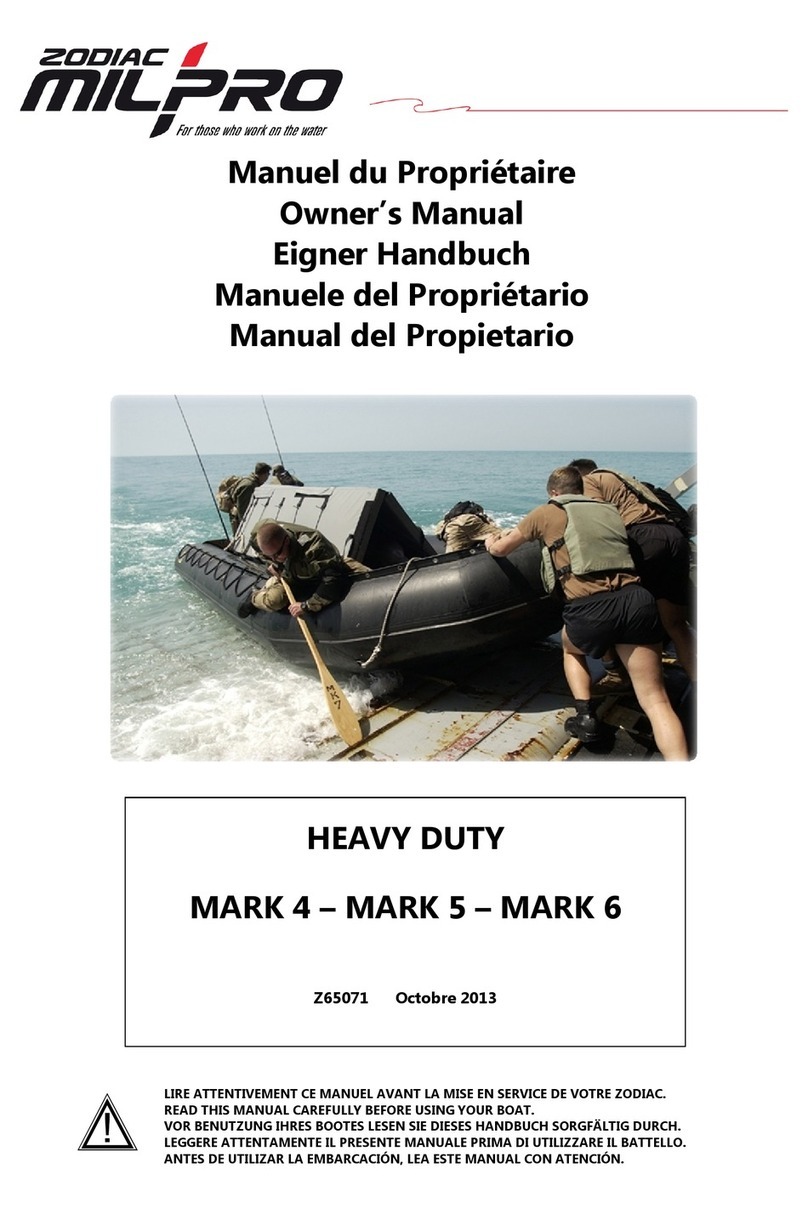
Zodiac
Zodiac MILPRO HEAVY DUTY Series owner's manual
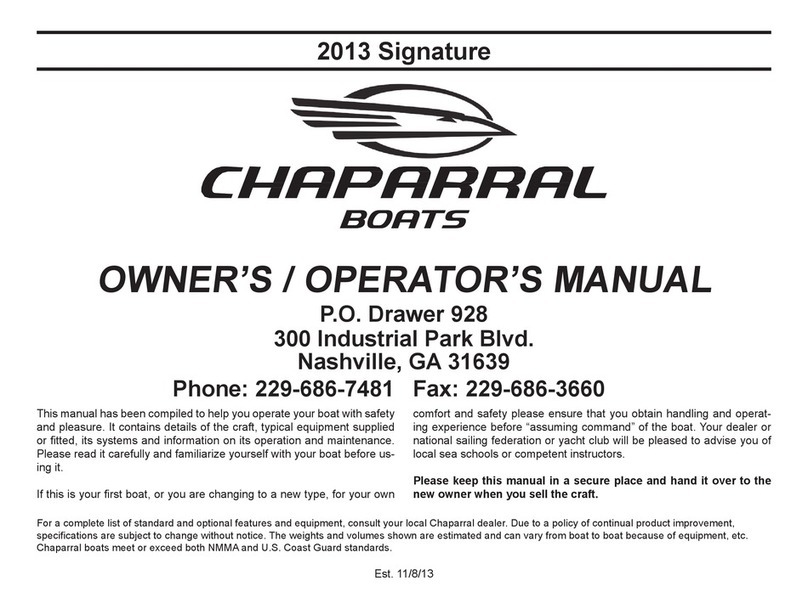
Chaparral
Chaparral SIGNATURE Owner's/operator's manual
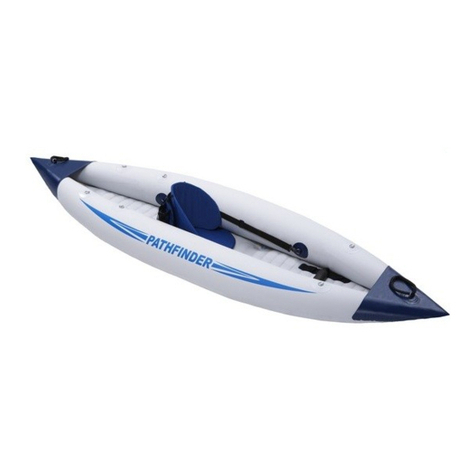
Jilong
Jilong PATHFINDER Series instruction manual
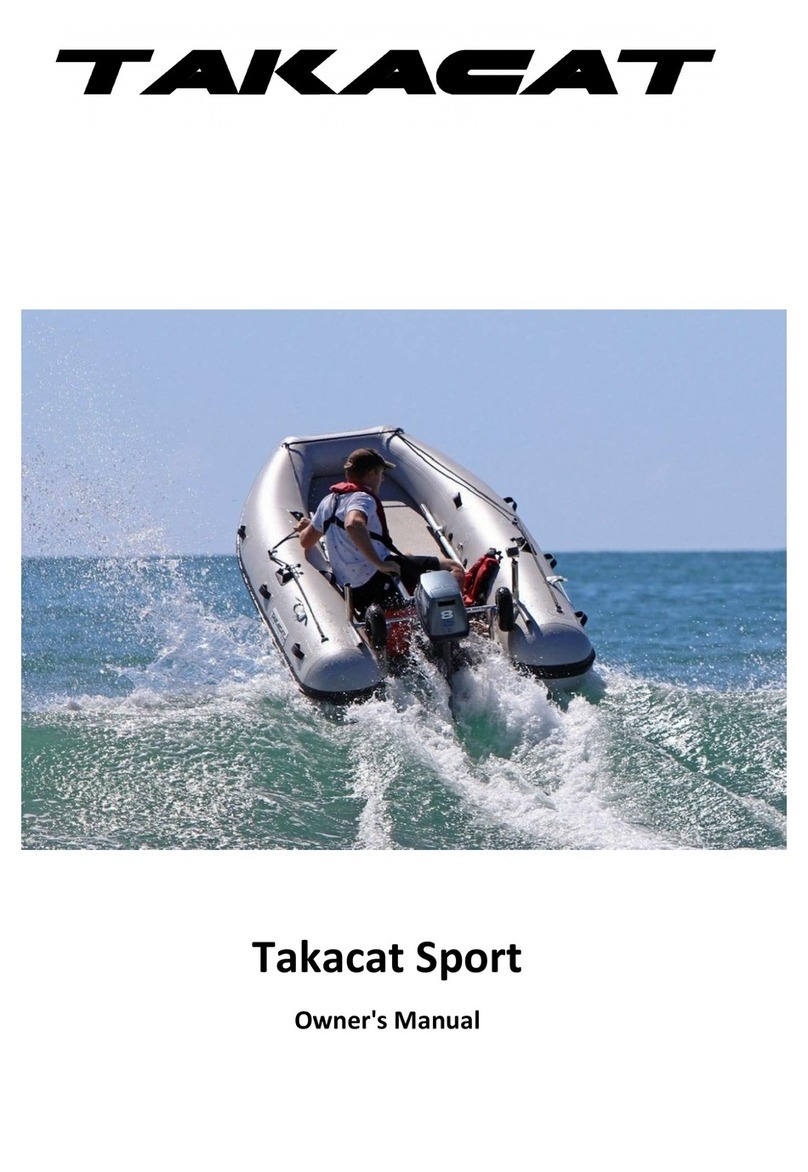
TAKACAT
TAKACAT Sport owner's manual

Hansa Sailing
Hansa Sailing Liberty owner's manual
